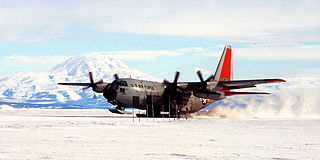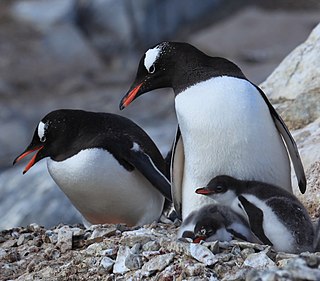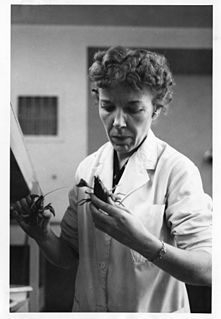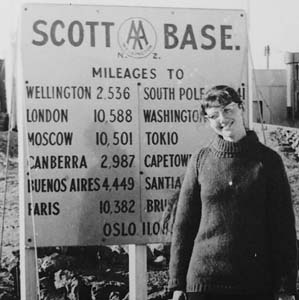Related Research Articles

The McMurdo Station is a United States Antarctic research station on the south tip of Ross Island, which is in the New Zealand–claimed Ross Dependency on the shore of McMurdo Sound in Antarctica. It is operated by the United States through the United States Antarctic Program, a branch of the National Science Foundation. The station is the largest community in Antarctica, capable of supporting up to 1,258 residents, and serves as one of three year-round United States Antarctic science facilities. All personnel and cargo going to or coming from Amundsen–Scott South Pole Station first pass through McMurdo. By road, McMurdo is 3 kilometres (1.9 mi) from New Zealand's smaller Scott Base.

Scott Base is a New Zealand Antarctic research facility at Pram Point on Ross Island near Mount Erebus in New Zealand's Ross Dependency territorial claim. The research facility was named in honour of Captain Robert Falcon Scott, RN, leader of two British expeditions to the Ross Sea area of Antarctica. The base was set up as support to field research and the centre for research into earth sciences, and now conducts research in many fields, operated by Antarctica New Zealand.

Palmer Station is a United States research station in Antarctica located on Anvers Island, the only US station located north of the Antarctic Circle. Initial construction of the station finished in 1968. The station, like the other U.S. Antarctic stations, is operated by the United States Antarctic Program (USAP) of the National Science Foundation. The base is about as distant from the equator as Fairbanks, Alaska.

The United States Antarctic Program is an organization of the United States government which has presence in the Antarctica continent. Founded in 1959, the USAP manages all U.S. scientific research and related logistics in Antarctica as well as aboard ships in the Southern Ocean.

Anvers Island or Antwerp Island or Antwerpen Island or Isla Amberes is a high, mountainous island 61 km long, the largest in the Palmer Archipelago of Antarctica. It was discovered by John Biscoe in 1832 and named in 1898 by the Belgian Antarctic Expedition under Adrien de Gerlache after the province of Antwerp in Belgium. It lies south-west of Brabant Island at the south-western end of the group. The south-western coastline of the island forms part of the Southwest Anvers Island and Palmer Basin Antarctic Specially Managed Area. Cormorant Island, an Important Bird Area, lies 1 km off the south coast.

Palmer Archipelago, also known as Antarctic Archipelago, Archipiélago Palmer, Antarktiske Arkipel or Palmer Inseln, is a group of islands off the northwestern coast of the Antarctic Peninsula. It extends from Tower Island in the north to Anvers Island in the south. It is separated by the Gerlache and Bismarck straits from the Antarctic Peninsula and Wilhelm Archipelago, respectively.

Arthur Harbour is a small harbour entered between Bonaparte Point and Amsler Island on the south-west coast of Anvers Island in the Palmer Archipelago of Antarctica.

Williams Field or Willy Field is a United States Antarctic Program airfield in Antarctica. Williams Field consists of two snow runways located on approximately 8 meters (25 ft) of compacted snow, lying on top of 8–10 ft of ice, floating over 550 meters (1,800 ft) of water. The airport, which is approximately seven miles from Ross Island, serves McMurdo Station and New Zealand's Scott Base. Until the 2009–10 summer season, Williams was the major airfield for on-continent aircraft operations in Antarctica.

A number of governments have set up permanent research stations in Antarctica and these bases are widely distributed. Unlike the drifting ice stations set up in the Arctic, the Research stations of the Antarctic are constructed either on rock or on ice that is fixed in place.

The Byrd Station is a former research station established by the United States during the International Geophysical Year by U.S. Navy Seabees during Operation Deep Freeze II in West Antarctica.
Peoples Rocks is a group of small islands off the coast of Anvers Island in Wylie Bay, located northeast of Norsel Point. Named for Ann Peoples, who served in a variety of positions from 1981–96; selected as the Berg Field Center Manager for McMurdo Station in 1986; first woman hired as a Station Manager; manager of Palmer Station 1991–96.

The Rosenthal Islands are a group of about islands fringing the west coast of Anvers Island, 11 km (6.8 mi) north of Cape Monaco, in the Palmer Archipelago of Antarctica.

Mary Alice McWhinnie was an American biologist, professor at DePaul University and an authority on krill from Chicago, Illinois She was the first woman to sail for two months in Antarctic waters aboard the NSF's research vessel, USNS Eltanin. The National Science Foundation eventually allowed her to winter over at McMurdo Station and in 1974, she became the first American woman to serve as chief scientist at an Antarctic research station.
Deneb Karentz is full-time faculty, professor, and chair of the Biology Department at University of San Francisco. Her research focuses on the ultraviolet photobiology of marine organisms and understanding their strategies for protection from UV exposure, particularly in relation to the ecological implications of Antarctic ozone depletion.

Michelle Rogan-Finnemore is a New Zealand-American science administrator, and currently the Executive Secretary of the Council of Managers of National Antarctic Programmes (COMNAP) which is the international association which brings together the National Antarctic Programs that make up its members. She is also the namesake of Finnemore Peak.

Lois M. Jones was an American geochemist who led the first all-woman science team to Antarctica in 1969. They were also the first women to reach the South Pole. Jones was well regarded for her contribution to geological research in the McMurdo Dry Valleys, one of the few ice-free areas of Antarctica, and published many papers and abstracts.

There have been women in Antarctica and exploring the regions around Antarctica for many centuries. Oral tradition of Māori explorers reaching Antarctic waters as early as 650 CE, put women on the Antarctic map. The most celebrated "first" for women was in 1935 when Caroline Mikkelsen became the first woman to set foot on one of Antarctica's islands. Early male explorers, such as Richard Byrd, named areas of Antarctica after wives and female heads of state. As Antarctica moved from a place of exploration and conquest to a scientific frontier, women worked to be included in the sciences. The first countries to have female scientists working in Antarctica were the Soviet Union, South Africa and Argentina.

This is a Timeline ofwomen in Antarctica. This article describes many of the firsts and accomplishments that women from various countries have accomplished in different fields of endeavor on the continent of Antarctica.

Marion Marie Stringer Darby was a New Zealand marine biologist and teacher. She was the first New Zealand woman to visit the Antarctic mainland. In January 1968, she travelled on the Magga Dan, the first tourist vessel to the Ross Sea, and visited Scott Base with other staff and tourists. She prepared a checklist of sub-Antarctic birds for the information of tourists on board and later wrote an article on summer seabirds to be seen between New Zealand and McMurdo Sound. Mt Darby in Antarctica is named after her.
While crime in Antarctica is relatively rare, isolation and boredom affect certain people there negatively and may lead to crime. Alcoholism is a known problem on the continent, and has led to fights and indecent exposure. Other types of crimes that have occurred in Antarctica include illicit drug use, torturing and killing wildlife, racing motorbikes through environmentally sensitive areas, assault with a deadly weapon, attempted murder, and arson. Sexual harassment also has been reported.
References
- 1 2 3 Phillips, Janet. "Three Women Manage Antarctic Stations". Amundsen-Scott South Pole Station. Retrieved 13 September 2016.
- 1 2 Rejcek, Peter (13 November 2009). "Longtime coming". Antarctic Sun. Retrieved 13 September 2016.
- 1 2 "Ann Peoples". Thomas Advisors. Retrieved 14 September 2016.
- ↑ "Peoples Rocks". Geographic.org. Retrieved 13 September 2016.